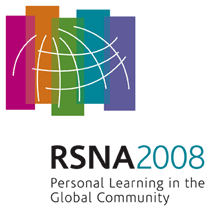
Abstract Archives of the RSNA, 2008
SSQ01-05
Diffusion-weighted Imaging for Differentiation of Breast Lesions in Patients: How Does Selection of Diffusion Schemes Affect Diagnosis?
Scientific Papers
Presented on December 4, 2008
Presented as part of SSQ01: ISP: Breast Imaging (MR Imaging Techniques)
Wolfgang Bogner MSC, Presenter: Nothing to Disclose
Stephan Gruber MD, Abstract Co-Author: Nothing to Disclose
Günther Grabner, Abstract Co-Author: Nothing to Disclose
Andreas Stadlbauer MS, Abstract Co-Author: Nothing to Disclose
Thomas Helbich MD, Abstract Co-Author: Nothing to Disclose
Siegfried Trattnig MD, Abstract Co-Author: Nothing to Disclose
To evaluate the effect of b-value choice on magnitude and accuracy of apparent diffusivity constant (ADC) maps, tumor-to-tissue-contrast on diffusion weighted images (DWI) and implications on the differentiation of breast lesions in vivo.
45 women (age: 45±11 years) suspect for breast cancer were examined. A single-shot echo-planar imaging sequence with 10 different diffusion weighting strengths (b-values) ranging from 0 to 1250 s/mm² was added to a standard MR protocol (TR/TE/TI=13700/83/220, FOV 350x117 mm, matrix 192x64 transversal; 40 slices; SI 3.5 mm, 2 averages). ADC was calculated for combinations of the available b-values using different fitting algorithms and compared to the gold standard (using all b-values). 103 ROIs were placed on DWIs in 15 malignant and 14 benign biopsy proven lesions, 41 healthy tissue areas and 33 cysts and applied to all maps. Lesion contrast on DWI was calculated for all b-values. Coefficient of variation (CV) was used to estimate accuracy of ADC within ROIs. ADC and contrast differences among tissue types were analyzed by ANOVA.
ADC (mean±SD×10-3 mm²/s) values found for the gold standard were 1.07±0.14, 1.48±0.11, 1.89±0.21 and 2.68±0.28 for malignant, benign, healthy and cystic tissue respectively. Non-linear fitting achieved ~4-5% higher ADC values. An ADC threshold of 1.27 discriminated malignant from benign lesions with one false-positive. Higher ADC values were found for low b-value combinations in all tissue types except for cysts, leading to a decrease in the optimal treshold of -16% for b=0/400 or -4% for b=0/850 compared to 0/1250 . Optimal ADC accuracy was found for b>700 s/mm² but increased only insignificantly with increasing number of b-values: using 4 (+1%), 7(+10%) or all (+10%). Maximum lesion/tissue-contrast was found between 850 and 1000 s/mm² for benign and malignant lesions.
Due to perfusion and compartment effects ADC differences among prior studies and consequently thresholds for discrimination of breast lesions are dependent on b-value schema. Optimal diagnostic quality was found combining b=50 s/mm² and b=850 s/mm².
Knowledge of DWI contrast and ADC accuracy dependencies on parameter settings help radiologists in optimizing diagnostic quality of breast DWI measurements.
Bogner, W,
Gruber, S,
Grabner, G,
Stadlbauer, A,
Helbich, T,
Trattnig, S,
Diffusion-weighted Imaging for Differentiation of Breast Lesions in Patients: How Does Selection of Diffusion Schemes Affect Diagnosis?. Radiological Society of North America 2008 Scientific Assembly and Annual Meeting, February 18 - February 20, 2008 ,Chicago IL.
http://archive.rsna.org/2008/6019778.html

